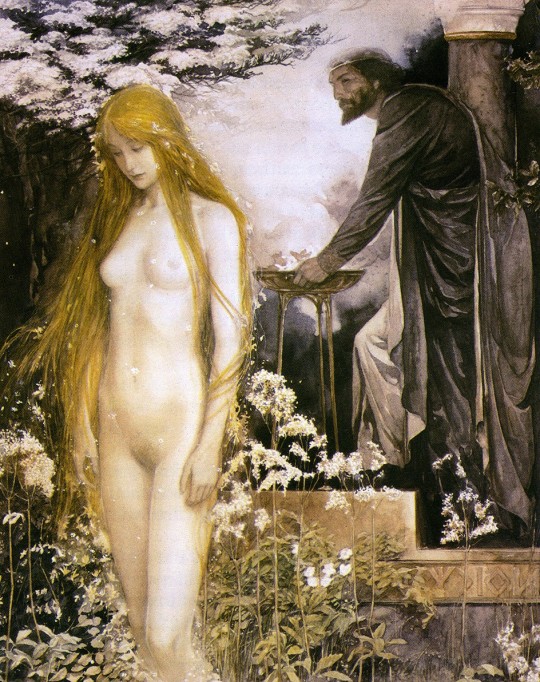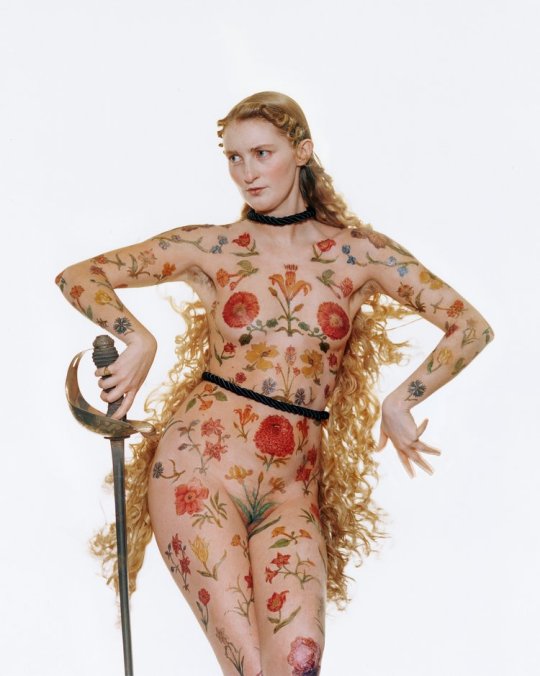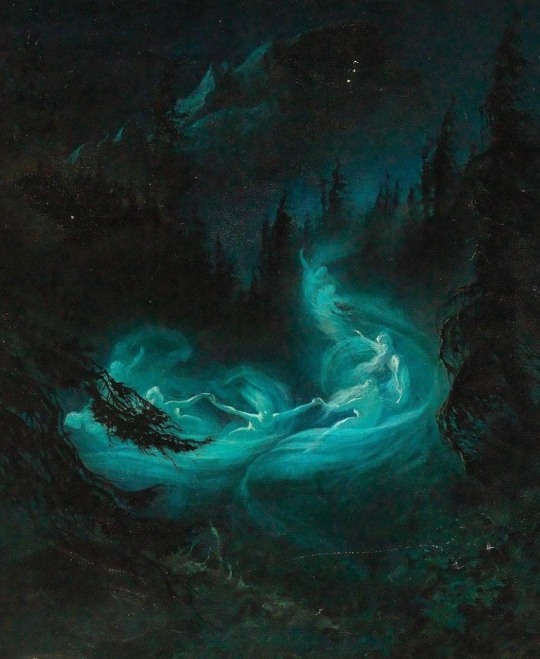Text




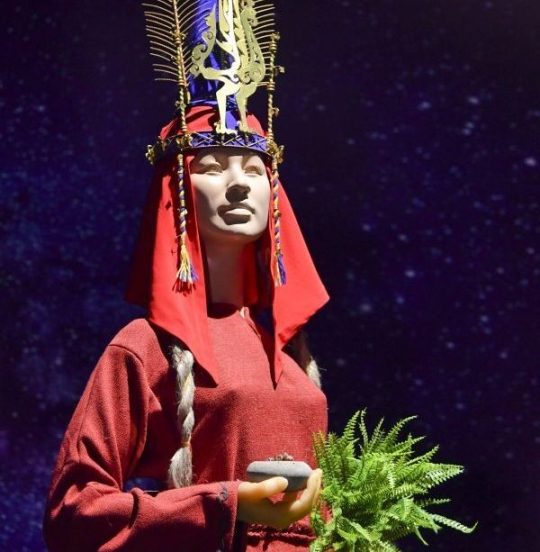

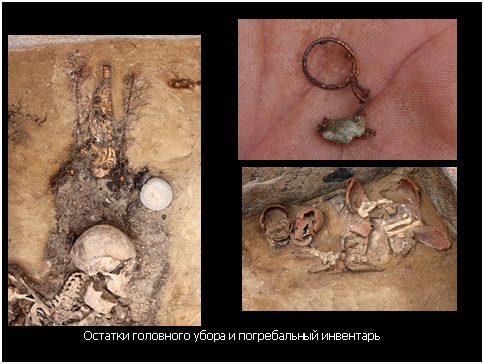
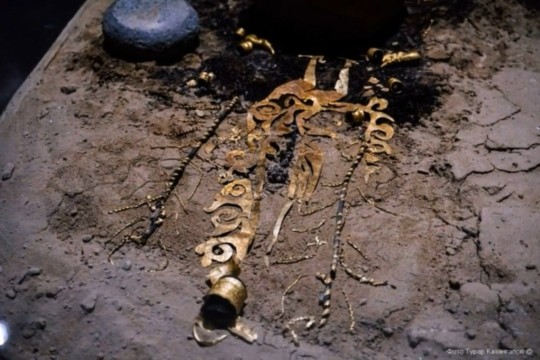
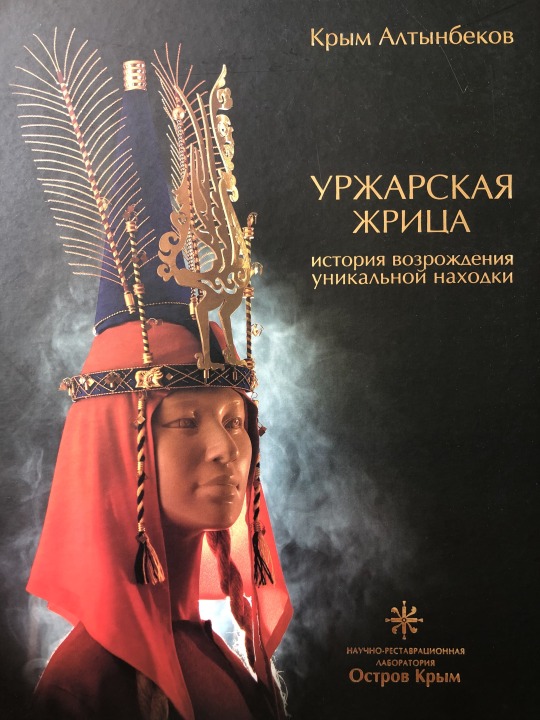

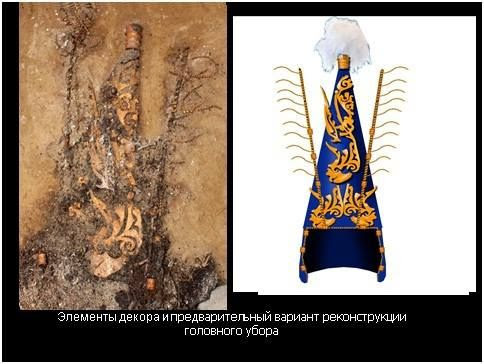

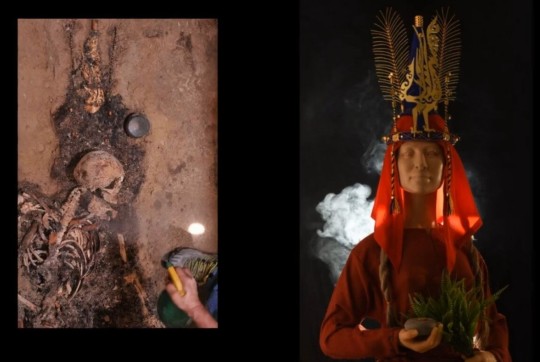

The Urzhar Priestess 5th-3rd C. BCE.
"Powerful plants: Study of ancient plant remains and written sources has shown that the Saka had a sophisticated knowledge of the medicinal and stimulant properties of plants. They had access to a rich natural medicine cabinet, in addition to those plants they may have cultivated themselves. The ‘Urzhar priestess’ was buried with a wig made of grasses, and a variety of medicinal herbs. Ferns were known to have anti-inflammatory, antiseptic, and painrelieving properties. Cumin, thistle, and plantain were used for their bactericidal effect. Campion, used to treat poisoning and digestive issues, and cannabis for pain relief. In the wider Scythian world, finds of cannabis seeds with a burner from the Altai cemetery of Pazyryk show that it was used during funerary rituals. The Persians identified Saka ‘haoma-consumers’, an unknown plant with an intoxicating effect.
Reconstruction of the burial costume of the Urzhar priestess: Buried with a magnificent golden headdress and a mortar for grinding the medicinal herbs that were placed in her grave. Her high status is linked with her skills as a herbalist, and indicates that Saka respect for the natural world extended to plants as well as animals. Urzhar, modern reconstruction of Saka costume Linen, silk, bronze, wood, woollen cloth, metal alloy
Reconstruction by K. Altynbekov. КПо94-39116"
-taken from FitzMuseum
179 notes
·
View notes
Text




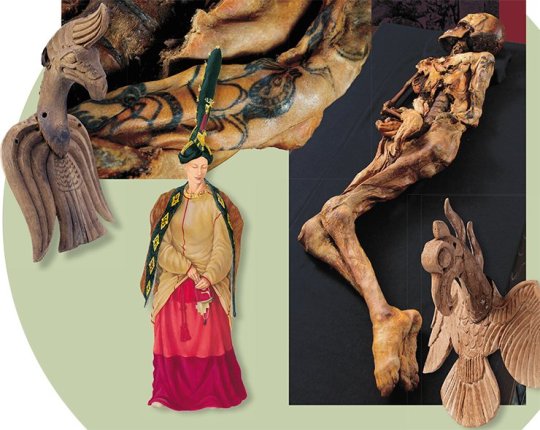
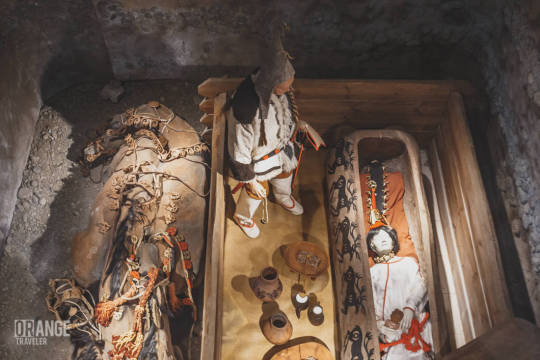
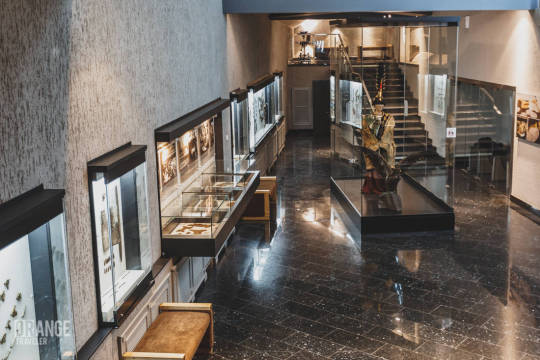








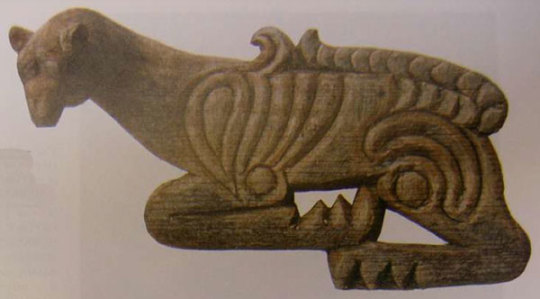




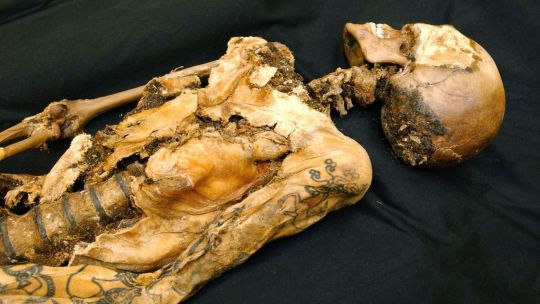
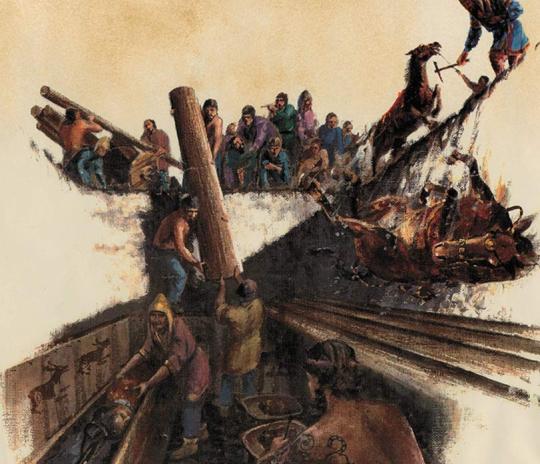
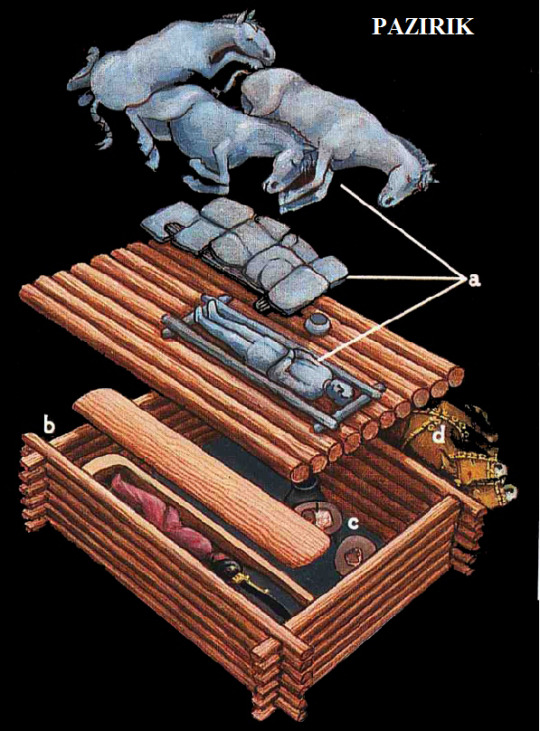
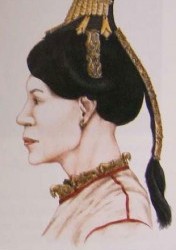




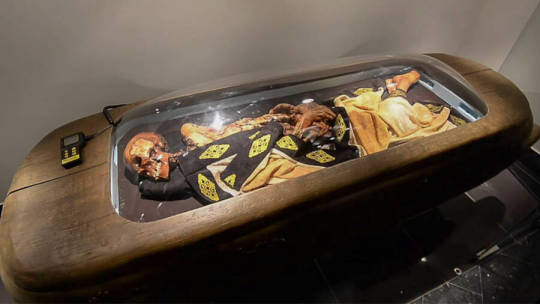

The Princess of Ukok (aka Siberian Ice Maiden & The White Lady) 500 BCE. Tumblr image limit only allows 30 photos, I will include a link to my blog, at bottom, with more photos and more organized descriptions.
"In 1993, Russian archaeologist Natalya Polosmak and her team discovered an ancient tomb at the Ukok Plateau, in the Altai Mountains region of Russia near the border with China.
The ‘Maiden’ belonged to the Pazyryk culture. The Pazyryk people, a congregation of Scythian nomadic tribes, lived in the Altai mountains in the 6th to 3rd centuries B.C.
The woman’s body, carefully embalmed using peat and bark, was laid on its side as if she were asleep. She was young and her hair was shaved, but she wore a wig and a tall hat. She was 167cm tall. Some tribal animal-style tattoos remained on her pale skin: creatures with horns that evolved into floral shapes. Her coffin was made large enough to accommodate the 90cm felt headdress she wore. She was also wearing a long wool skirt with red and white stripes and white felt stockings.
'A mop of hair on top was tightly wrapped around with a woollen cord, which helped this mop to stand upright,' she says. 'On top of this mop was worn a red 'nakosnik' (a braided decoration made from threads), and atop of this structure was a bronze pin with a deer, standing on a sphere. The deer was made from wood, and was covered in golden foil.' Yet it was more intricate, still. 'The wig had another very important detail,' she says. Its crowning glory looked like a giant feather, 68.5 cm long, made from felt and covered with black woollen fabric, with a stick inside it to help it stand straight.' she says. 'This feather had the figures of 15 birds attached to it, which like in modern Russian Matryoshkha dolls with one inside another, were each of smaller size compared to the previous one. The birds had leather wings, tails and legs, and long necks, which most likely meant they were swans. 'This feather can be interpreted as a symbol of the Tree of Life - a healing tree which existed in so many cultures all around the planet. By the roots of the tree there is a wooden figure of a deer with a Capricorn's antlers. 'There was also ... a cap for the wig.... some 84 cm tall. It was found in Princess Ukok's burial chamber.'
The Altai princess became the second mummy found with a tattoo (tattoo had not yet been found on other, earlier mummies in the Hermitage). Kurgan 1, burial ground Ak-Alakha-3 (Ukok Plateau, Altai). Tattoos were inked on both arms from shoulders to hands. The drawings were blue and stood out against the white skin. They were preserved only on the left hand, on the right they were almost completely destroyed. Drawings were also applied to some phalanges of both hands. Archaeologists saw the tattoos during the opening of the wooden sarcophagus, then the mummy's skin began to darken, and the tattoos disappeared, subsequently they were restored in the laboratory. When other Pazyryk mummies were found, the tattoos were not visually noticeable.
The tattoos on the left shoulder of the 'princess' show a fantastical mythological animal: a deer with a griffon's beak and a Capricorn's antlers. The antlers are decorated with the heads of griffons. And the same griffon's head is shown on the back of the animal. The mouth of a spotted panther with a long tail is seen at the legs of a sheep. She also has a deer's head on her wrist, with big antlers. There is a drawing on the animal's body on a thumb on her left hand.
Somehow, many Pazyryk burials in this region were flooded, possibly with underground waters, and then froze – so the organic remains were preserved almost untouched by decay.
The embalmed body was buried at least three months after death. All this time, the mysterious woman continued to play a special role in the life of her tribe — for example, she was put in some chairs, which can be seen from the traces on the body. At the same time, a complex, time-consuming ceremony of embalming is a sign of the extraordinary status of the deceased. However, the scientists deny her status as a ‘Princess.’
“It’s not accurate to call her a ‘princess’. She was not a princess, she was a representative of the middle layer of the Pazyryk society,” archaeologist Vyacheslav Molodin, academician at the Russian Academy of Sciences, and Natalya Polosmak’s husband, told “Expert-Siberia” magazine in 2012.
Studies of the mummified remains extraordinary advances in our understanding of her rich and ingenious Pazyryk culture. The tattoos on her skin are works of great skill and artistry, while her fashion and beauty secrets - from items found in her burial chamber which even included a 'cosmetics bag' - allow her impressive looks to be recreated more than two millennia after her death.
The princess' cosmetic kit included a black horsehair brush with a thin wooden shaft inside, tied with a (disappeared) leather cord, completely studded with cylindrical marble beads, and handfuls of scattered powder of bright blue-green color. There were also the remains of a broken thin rod of flat metal rings filled with the same blue-green substance (that is, in fact, it is a pencil for drawing lines or drawings like our eyeliner).
Analysis showed that it was vivianite (blue iron ore). Such a powder, closer to modern times, was used to obtain green paint. In the Altai Mountains, it is known as a satellite of gold-bearing sands. Perhaps this powder had a sacred meaning. The vivianite pencil may have been used for face painting, possibly for people with special functions or gifts. Among the Pazyryks, face and body painting has not been recorded, partly because not a single mummified face has been found. But among the peoples close to the Pazyryks, such a tradition was recorded, in particular, the painting of the face with two spiral drawings. There is a weak association with the blue-green turquoise Hathor from the Sinaiand numerous Sumerian green cosmetic "shadows" in boxes discovered during excavations in Ur and other cities of Sumer.
It is believed that she was not in fact a royal but that her use of drugs to cope with the symptoms of her illnesses may have given her 'an altered state of mind', leading her kinsmen to the belief that she could communicate with the spirits. Her lavish grave suggests she was someone of singular importance.
The MRI, conducted in Novosibirsk by eminent academics Andrey Letyagin and Andrey Savelov, showed that the 'princess' suffered from osteomyelitis, an infection of the bone or bone marrow, from childhood or adolescence. Close to the end of her life, she was afflicted, too, by injuries consistent with a fall from a horse.
The mystery was solved only in the 2010s with the help of a computed tomography scan. It showed that the maiden suffered from breast cancer that killed her in about three years. She was 25 at the time of her death.
'During the imaging of mammary glands, we paid attention to their asymmetric structure and the varying asymmetry of the MR signal,' stated Dr Letyagin in his analysis. 'We are dealing with a primary tumour in the right breast and right axial lymph nodes with metastases.'
'The three first thoracic vertebrae showed a statistically significant decrease in MR signal and distortion of the contours, which may indicate the metastatic cancer process.' He concluded: 'I am quite sure of the diagnosis - she had cancer.
'She was extremely emaciated. Given her rather high rank in society and the information scientists obtained studying mummies of elite Pazyryks, I do not have any other explanation of her state. Only cancer could have such an impact.'
'When she arrived in winter camp on Ukok in October, she had the fourth stage of breast cancer,' she wrote. 'She had severe pain and the strongest intoxication, which caused the loss of physical strength. 'In such a condition, she could fall from her horse and suffer serious injuries. She obviously fell on her right side, hit the right temple, right shoulder and right hip. Her right hand was not hurt, because it was pressed to the body, probably by this time the hand was already inactive. Though she was alive after her fall, because edemas are seen, which developed due to injuries.
The DNA research performed on the remains showed that the ‘Maiden’ is genetically closely related to contemporary Selkup and Ket peoples – indigenous Siberian tribes still living in Russia.
'There was a moment of gross misunderstanding when a legend came about this mummy being a foremother of people of Altai,' said Molodin.
'The people of Pazyryk belonged to different ethnic group, in no way related to Altaians. Genetic studies showed that the Pazyryks were a part of Samoyedic family, with elements of Iranian-Caucasian substratum.'
So perhaps more Samoyedic than Scythian.
'We tried to overcome the misunderstanding, but sadly it didn't work.'
The Altai authorities have now declared the remote mountain area from where the princess and her kinsmen were buried as a 'zone of peace' where no more excavations will take place, despite the near-certain treasures lying in the permafrost.
Such work amounts to plundering, they believe.
To Molodin, who found the male mummy several years after the princess, this deprives the world of a valuable scientific inheritance. He argues, too, that the issue is critical since global warming means the ancient bodies will decay.
Scientists reckon there are thousands of burial mounds here, hundreds of which date to the Pazyryk period, many of which may contain answers to questions about where we come from.
The ancient mummy of a mysterious young woman, known as the Ukok Princess, is finally returning home to the Altai Republic this month (The Siberian Times, August 2012).
On 19 May 2014, during a speech at the museum, (Alexander) Berdnikov reminded the crowd and media that the renovation and repatriation of the Altai Princess was one of his most important accomplishments, of course aided by Gazprom:
We should be proud that we have such a museum. A great accomplishment; we thank the management of Gazprom. When I was appointed as the Head [of the Altai Republic] one of my main goals and dreams was to have a bright opening of a renovated museum and that we could welcome the “Siberian Ice Maiden” home again. Today our museum is the best one east of the Urals and is the only one that has been restored in Russia in the past twenty years. (Government of the Altai Republic 2014)
The museum, the repatriated Altai Princess, and a vibrant cultural life, all indirectly bankrolled by Gazprom."
-taken from The Siberian Times, Russia Beyond, Taylor & Francis Online, world-jewellery livejournal, and peaceandjustice
317 notes
·
View notes
Photo

Celtic Queen Boudica and the Morrigu by Howard David Johnson
NOTE: Actually, the goddess invoked by Boudica was Andraste.
114 notes
·
View notes
Photo

Paris and the Nymph Oenone race light-heartedly through the woodland wilds of Mt. Ida fresh with springs.
1K notes
·
View notes
Photo

Sun, I hail thee!, from Wagner’s Siegfried & The Twilight of the Gods by Arthur Rackham (1910)
2K notes
·
View notes
Photo

“Frostbite”. Klara Alba Gordon by Emre Ünal for Novembre Magazine online June 2022
12K notes
·
View notes
Photo

Combat Scene: Horseman Defending Himself Against Four Infantry Men. circa 1506 -11. Gianfrancesco Rustici Italian 1474-1554. terracotta. http://hadrian6.tumblr.com
152 notes
·
View notes
Text
Harvest Festival (Erntedankfest) with Bronze Age theme.
Germany, 1933.





27 notes
·
View notes





